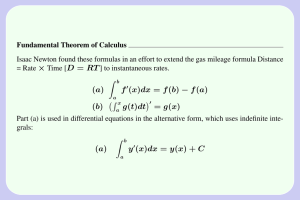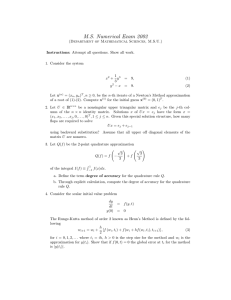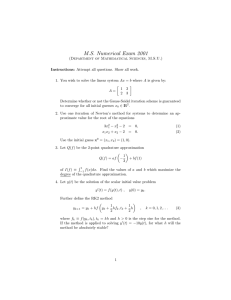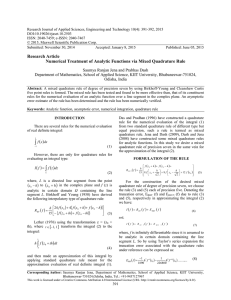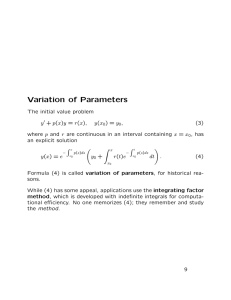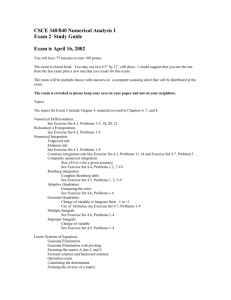Document 13307053
advertisement
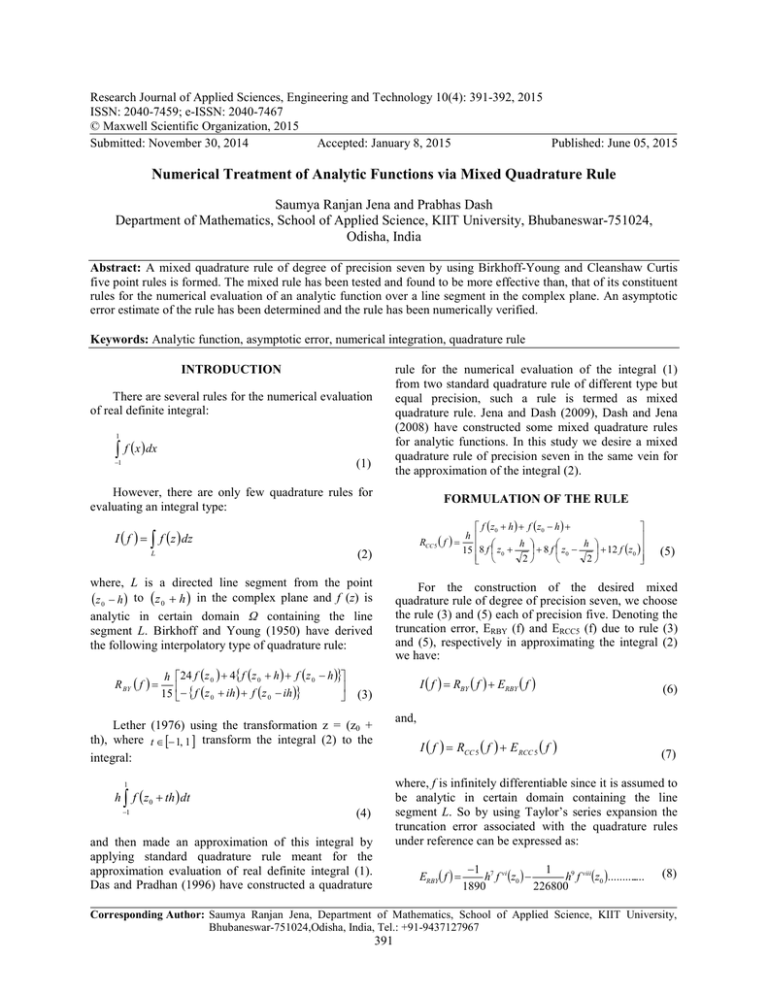
Research Journal of Applied Sciences, Engineering and Technology 10(4): 391-392, 2015
ISSN: 2040-7459; e-ISSN: 2040-7467
© Maxwell Scientific Organization, 2015
Submitted: November 30, 2014
Accepted: January 8, 2015
Published: June 05, 2015
Numerical Treatment of Analytic Functions via Mixed Quadrature Rule
Saumya Ranjan Jena and Prabhas Dash
Department of Mathematics, School of Applied Science, KIIT University, Bhubaneswar-751024,
Odisha, India
Abstract: A mixed quadrature rule of degree of precision seven by using Birkhoff-Young and Cleanshaw Curtis
five point rules is formed. The mixed rule has been tested and found to be more effective than, that of its constituent
rules for the numerical evaluation of an analytic function over a line segment in the complex plane. An asymptotic
error estimate of the rule has been determined and the rule has been numerically verified.
Keywords: Analytic function, asymptotic error, numerical integration, quadrature rule
rule for the numerical evaluation of the integral (1)
from two standard quadrature rule of different type but
equal precision, such a rule is termed as mixed
quadrature rule. Jena and Dash (2009), Dash and Jena
(2008) have constructed some mixed quadrature rules
for analytic functions. In this study we desire a mixed
quadrature rule of precision seven in the same vein for
the approximation of the integral (2).
INTRODUCTION
There are several rules for the numerical evaluation
of real definite integral:
1
∫ f (x ) dx
(1)
−1
However, there are only few quadrature rules for
evaluating an integral type:
I ( f ) = ∫ f ( z ) dz
L
FORMULATION OF THE RULE
RCC 5 ( f ) =
(2)
where, L is a directed line segment from the point
(z 0 − h ) to (z 0 + h ) in the complex plane and f (z) is
analytic in certain domain Ω containing the line
segment L. Birkhoff and Young (1950) have derived
the following interpolatory type of quadrature rule:
R BY ( f ) =
h 24 f ( z 0 ) + 4{ f ( z 0 + h ) + f ( z 0 − h )}
15 − { f ( z 0 + ih ) + f ( z 0 − ih )}
(3)
I ( f ) = RBY ( f ) + ERBY ( f )
(6)
I ( f ) = RCC 5 ( f ) + E RCC 5 ( f )
(7)
and,
where, f is infinitely differentiable since it is assumed to
be analytic in certain domain containing the line
segment L. So by using Taylor’s series expansion the
truncation error associated with the quadrature rules
under reference can be expressed as:
1
−1
(5)
For the construction of the desired mixed
quadrature rule of degree of precision seven, we choose
the rule (3) and (5) each of precision five. Denoting the
truncation error, ERBY (f) and ERCC5 (f) due to rule (3)
and (5), respectively in approximating the integral (2)
we have:
Lether (1976) using the transformation z = (z0 +
th), where t ∈ [− 1, 1 ] transform the integral (2) to the
integral:
h ∫ f ( z0 + th ) dt
f ( z0 + h ) + f ( z0 − h ) +
h
h
h
15 8 f z0 +
+ 12 f ( z0 )
+ 8 f z0 −
2
2
(4)
and then made an approximation of this integral by
applying standard quadrature rule meant for the
approximation evaluation of real definite integral (1).
Das and Pradhan (1996) have constructed a quadrature
ERBY ( f ) =
−1 7 vi
1
h f (z0 ) −
h9 f viii(z0 )..............
1890
226800
(8)
Corresponding Author: Saumya Ranjan Jena, Department of Mathematics, School of Applied Science, KIIT University,
Bhubaneswar-751024,Odisha, India, Tel.: +91-9437127967
391
Res. J. App. Sci. Eng. Technol., 10(4): 391-392, 2015
Table 1: Mixed quadrature rule RBYCC5 (f)
Quadrature rule
Approximation value I1
RBY (f)
1.682417145154309 i
1.682967877663091 i
RCC5 (f)
1.682941652305530 i
RBYCC5 (f)
Exact value
1.682941969615793 i
E RCC 5 ( f ) =
2
h7 f
105 × 6!
vi
(z 0 ) +
1
h9 f
45 × 8!
viii
(z 0 ) + .......
Approximation value I2
2.350936031119045 i
2.350375376931479 i
2.350402074749935 i
2.350402387287603 i
E RCC 5 ( f
)
Approximation value I3
0.654389151885734 i
0.654389405660818 i
0.654389393576290 i
0.654389393592304 i
≤ E RBY ( f
)
(14)
(9)
And from (13):
ଵ
Multiplying ( ) in Eq. (6) and adding it to Eq. (7):
ଶ
E RBYCC 5 ( f ) ≤ E RCC 5 ( f )
1
1
I ( f ) = [20RCC 5 ( f ) + RBY ( f )] + [20ERCC5 ( f ) + ERBY ( f )] (10)
21
21
From (14) and (15):
where,
E RBYCC 5 ( f ) ≤ E RCC 5 ( f ) ≤ E RBY ( f
RBYCC5 ( f ) =
1
[20 RCC 5 ( f ) + RBY ( f )]
21
E RBYCC 5 ( f ) =
1
[20 ERCC 5 ( f ) + ERBY ( f )]
21
(15)
)
(16)
NUMERICAL VERIFICATION
(11)
Let us approximate the value of the following
integrals I 1 , I 2 , I 3 using RBY ( f ) , RCC 5 ( f ) , RBYCC5 ( f )
quadrature rule.
where,
(12)
where, Eq. (11) is the desired mixed quadrature rule of
degree of precision seven.
i
i
−i
−i
i
3
I 1 = ∫ e z dz , I 2 = ∫ cos z dz , I 3 = cosh z dz
∫
Error analysis: Let f (z) is analytic in the disc:
Ω R = {z : z − z 0 ≤ R > h }
−i
3
CONCLUSION
So that the point z0, (z0±h), (z0±ih) all are interior
to the disc Ωோ . Now using Taylor’s expansion:
∞
f (z ) = ∑ an (z − z 0 )
From the Table 1 it is evident that the mixed
quadrature rule R BYCC 5 ( f ) of degree of precision seven
is giving us better result than the constituent rules
RBY ( f ) , RCC 5 ( f ) each of degree of precision five. Our
n
n=0
quadrature rule is more efficient and numerically better
convergent to exact result.
where,
an =
1
f
n!
n
(z 0 )
REFERENCES
Birkhoff, G. and D. Young, 1950. Numerical
quadrature of analytic and harmonic functions.
J. Math. Phys., 29: 217.
Das, R.N. and G. Pradhan, 1996. A mixed quadrature
rule for approximate evaluation of real definite
integrals. Int. J. Math. Educ. Sci., 27: 279-283.
Dash, R.B. and S.R. Jena, 2008. A mixed quadrature of
modified Birkhoff-Young using Richardson
extrapolation
and
Gauss-Legendre-4
point
transformed rule. Int. J. Appl. Math. Appl., 2:
111-117.
Jena, S.R. and R.B. Dash, 2009. Mixed quadrature of
real definite integrals over triangles. Paci-Asian
J. Math., 3: 119-124.
Lether, F.G., 1976. On Birkhoff-Young qadrature of
analytic functions. J. Comut. Appl. Math., 2: 81.
In (12), we obtain after simplification:
E RBYCC 5 ( f ) =
1
h 9 f viii (z 0 ) + ..............
75 × 8!
(13)
Thus the mixed quadrature rule RBYCC5 (f) is of
precision seven.
Theorem 1: If f is assumed to be analytic in domain Ω
containing L then:
( )
E RBYCC 5 ( f ) = O h 9
Error comparison: From (8) and (9):
392
